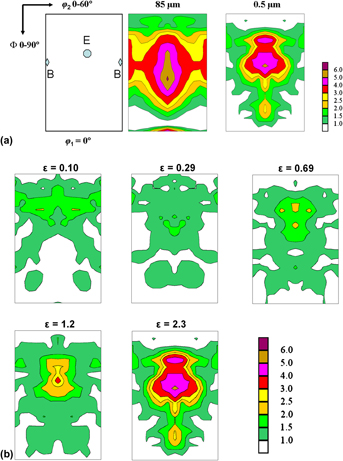Crossref Citations
This article has been cited by the following publications. This list is generated based on data provided by
Crossref.
Pushkareva, Marina
Adrien, Jérôme
Maire, Eric
and
Weck, Arnaud
2012.
Proceedings of the 1st International Conference on 3D Materials Science.
p.
61.
Gurao, N. P.
Sethuraman, S.
and
Suwas, Satyam
2013.
Evolution of Texture and Microstructure in Commercially Pure Titanium with Change in Strain Path During Rolling.
Metallurgical and Materials Transactions A,
Vol. 44,
Issue. 3,
p.
1497.
Pushkareva, Marina
Adrien, Jérôme
Maire, Eric
and
Weck, Arnaud
2013.
1stInternational Conference on 3D Materials Science.
p.
61.
Polyakov, Alexander
Gunderov, Dmitry
Sitdikov, Vil’
Valiev, Ruslan
Semenova, Irina
and
Sabirov, Ilchat
2014.
Physical Simulation of Hot Rolling of Ultra-fine Grained Pure Titanium.
Metallurgical and Materials Transactions B,
Vol. 45,
Issue. 6,
p.
2315.
Nurmi, E.
Tuuli, E.
Levämäki, H.
Kokko, K.
Leiro, J.
and
Vitos, L.
2016.
Directional Young’s modulus of single-crystal and cold-rolled titanium fromab initiocalculations: Preferred crystal orientation due to cold rolling.
Philosophical Magazine,
Vol. 96,
Issue. 26,
p.
2736.
Pushkareva, Marina
Adrien, Jérôme
Maire, Eric
Segurado, Javier
Llorca, Javier
and
Weck, Arnaud
2016.
Three-dimensional investigation of grain orientation effects on void growth in commercially pure titanium.
Materials Science and Engineering: A,
Vol. 671,
Issue. ,
p.
221.
Fuloria, Devasri
Kumar, Nikhil
Jayaganthan, R.
Jha, S.K.
and
Srivastava, D.
2017.
Microstructural and textural characterization of Zircaloy-4 processed by rolling at different temperatures.
Materials Characterization,
Vol. 127,
Issue. ,
p.
296.
Fuloria, Devasri
Kumar, Nikhil
Jayaganthan, R.
Jha, S.K.
and
Srivastava, D.
2017.
An investigation of effect of annealing at different temperatures on microstructures and bulk textures development in deformed Zircaloy-4.
Materials Characterization,
Vol. 129,
Issue. ,
p.
217.
Yang, Huanping
Wang, Yaomian
Akca, H.
Luca Tudorache, R.
and
Abdullah, L.
2018.
Effect of Shear Deformation on Texture Evolution in Rolled Pure Titanium.
MATEC Web of Conferences,
Vol. 186,
Issue. ,
p.
02002.
Nichul, Unissa
Khatirkar, Rajesh
Dhole, Ashish
and
Hiwarkar, Vijay
2021.
Cold compression behavior on the evolution of microstructure and texture in Beta C titanium alloy.
Journal of Alloys and Compounds,
Vol. 887,
Issue. ,
p.
161400.
Mishra, Sumeet
Yazar, K. U.
Kar, Amlan
Lingam, R.
Reddy, N. V.
Prakash, Om
and
Suwas, Satyam
2021.
Texture and Microstructure Evolution During Single-Point Incremental Forming of Commercially Pure Titanium.
Metallurgical and Materials Transactions A,
Vol. 52,
Issue. 1,
p.
151.
Panda, D.
Sabat, R. K.
Suwas, S.
and
Sahoo, S. K.
2022.
Role of temperature and precipitates on the evolution of microstructure and texture during grain growth of Mg–3Al–0.2Ce alloy.
Philosophical Magazine,
Vol. 102,
Issue. 12,
p.
1091.
Kariya, Shota
Issariyapat, Ammarueda
Bahador, Abdollah
Umeda, Junko
Shen, Jianghua
and
Kondoh, Katsuyoshi
2022.
Ductility improvement of high-strength Ti–O material upon heteromicrostructure formation.
Materials Science and Engineering: A,
Vol. 842,
Issue. ,
p.
143041.
Kariya, Shota
Issariyapat, Ammarueda
Bahador, Abdollah
Umeda, Junko
Shen, Jianghua
and
Kondoh, Katsuyoshi
2023.
Effect of grain size on the tensile ductility and fracture mechanism of Ti–O alloys.
Materials Science and Engineering: A,
Vol. 874,
Issue. ,
p.
145068.
Thool, Khushahal
Yazar, K. U.
Kavimani, V.
Gupta, Aman
and
Choi, Shi-Hoon
2024.
Microstructural and Textural Evolution in Hexagonal Close-Packed Metals: The Case of Zirconium, Magnesium, and Titanium.
Crystals,
Vol. 14,
Issue. 8,
p.
727.
Ahmadikia, Behnam
Paraskevas, Orestis
Van Hyning, William
Hestroffer, Jonathan M.
Beyerlein, Irene J.
and
Thrampoulidis, Christos
2024.
Data-driven texture design for reducing elastic and plastic anisotropy in titanium alloys.
Acta Materialia,
Vol. 265,
Issue. ,
p.
119585.
Sharma, Arun
Shrivastava, Parnika
Nagargoje, Aniket
and
Mulay, Amrut
2025.
Multiscale residual stress analysis and microstructure characterization of Ti-grade 2 implant fabricated by adaptive tool path-driven SPIF process.
Materials Characterization,
Vol. 222,
Issue. ,
p.
114861.
